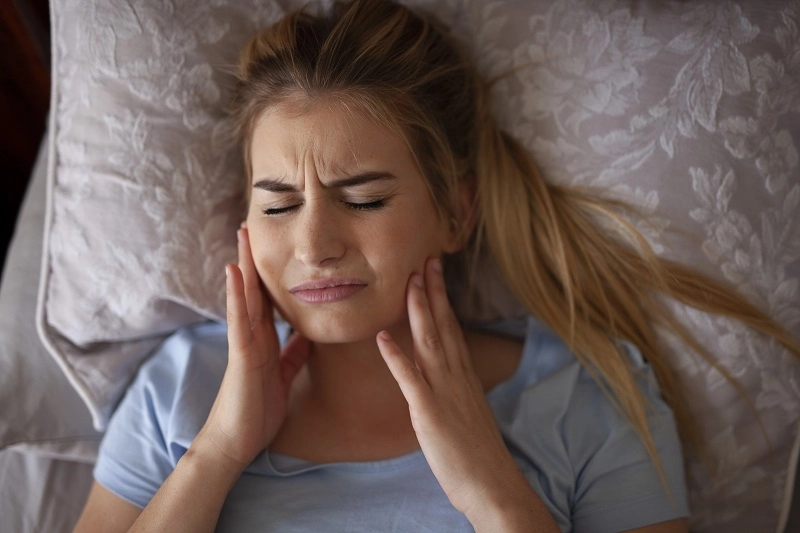Bruxism (Teeth grinding)
 BRUXISM, OR TEETH GRINDING, IS AN INVOLUNTARY TENSING AND/OR CLENCHING OF THE TEETH. ONE TREATMENT OPTION IS THE INJECTION OF MUSCLE RELAXANTS, OF WHICH WE HAVE LOTS OF EXPERIENCE IN OUR PRACTICE IN VIENNA. THIS TREATMENT OPTION IS FUNDAMENTALLY SUITABLE FOR ALL PATIENTS SUFFERING FROM BRUXISM.
BRUXISM, OR TEETH GRINDING, IS AN INVOLUNTARY TENSING AND/OR CLENCHING OF THE TEETH. ONE TREATMENT OPTION IS THE INJECTION OF MUSCLE RELAXANTS, OF WHICH WE HAVE LOTS OF EXPERIENCE IN OUR PRACTICE IN VIENNA. THIS TREATMENT OPTION IS FUNDAMENTALLY SUITABLE FOR ALL PATIENTS SUFFERING FROM BRUXISM.
Photo: © Hope - stock.adobe.com
-
Why does Bruxism or teeth grinding occur?
-
How common is Bruxism?
-
Why is Bruxism a problem?
-
How can Bruxism be treated?
-
What are the risks?
-
Is the treatment suitable for children?
-
What costs can I expect?
-
Is there a rest or recovery period after treatment?
Why does Bruxism or teeth grinding occur?
Bruxism is involuntary teeth grinding, tightening and/or clenching. Bruxism can occur during sleep (sleep bruxism) or during the day (wake bruxism). This is not subject to one's own will, it is not a habit, rather it is triggered unconsciously for various reasons and in different situations. These causes are divided into:
- Primary Bruxism – cause cannot be found
- Secondary Bruxism – Bruxism is a result of another medical condition
- Latrogenic Bruxism – Triggered by certain medications
The causes of Bruxism have not been clearly clarified despite numerous studies. It is currently believed that Bruxism originates in the brainstem. Masticatory muscle activity is triggered during the transition from different stages of sleep. In the case of waking Bruxism, it is assumed to be driven by conscious and unconscious states of tension. General risk factors for teeth grinding are sleep disorders, snoring, stress, anxiety, medication, alcohol, caffeine, and nicotine.
How common is Bruxism?
Bruxism is very common. Around a fifth of the population repeatedly suffers from it. Sleep Bruxism occurs in 15-20% of children and 13% of adults. Wake Bruxism is even more common at 22-31%. Bruxism occurs in young children and into old age. Prevalence tends to decrease over life span. The highest prevalence is in the second to third decades of life. No gender difference can be proven, women and men suffer from bruxism with a similar frequency.
Why is Bruxism a problem?
Clenching your teeth together puts stress on your teeth and jaw joints. The teeth themselves, but also the tooth neck and tooth roots are attacked. Tooth enamel is rubbed off and teeth can even be loosened. Implants, bridges, and other artificial dentures can be destroyed. The masticatory muscles, the jawbone and the jaw joints become overloaded. In addition, the bite position can be altered due to strain on the entire muscle and bone structure of the head and neck. One consequence of sleep Bruxism is poor sleep, which in turn creates higher levels of stress.
How can Bruxism be treated?
Dentists can offer bite guards to stop tooth wear. This is a simple plastic guard that is pulled over the teeth. The primary goal here is to protect the tooth structure.
Special massage techniques for relaxation can be learned together with a physiotherapist or osteopath.
The latest treatment option is the injection of substances for muscle relaxation, so-called muscle relaxants.The large masticatory muscle, the main cause of excessive jaw muscle activity, is relaxed in a very targeted manner. The masticatory muscle is softened, leaving the normal voluntary chewing function unchanged, but eliminating the involuntary and unwanted activity. The right dose and technique are crucial for this.
Prof. Dr. Rzany and Dr. Bisschoff have extensive experience treating Bruxism/teeth grinding.
The effect lasts around 4-6 months. Thereafter the treatment can be repeated to induce relaxation of the involuntary activity again. However, a general relaxation of the masticatory muscles is often achieved with one treatment, and further intervention is not necessary.
What are the risks?
The correct technique and experience of the doctor treating you is essential. Possible side effects are bruising, unbalanced action in the left and right chewing muscle, chewing problems and dry mouth. With expert intervention, these side effects can be largely eliminated.
A side effect of relaxing the masticatory muscles is that the face appears narrower. The enlarged jaw muscle recedes somewhat. This side effect pleases many patients.
Is the treatment suitable for children?
The treatment is extremely rarely used in children.
What costs should I expect?
The cost of treatment depends on the amount of muscle relaxant required and is between EUR 400-600 per session. Statutory health insurance does not make any co-payments, private supplementary insurance partially reimburses part or all of the treatment.
Is there a rest or recovery period after treatment?
There is no downtime necessary after the treatment. The desired effect usually occurs after about 2 weeks.



